
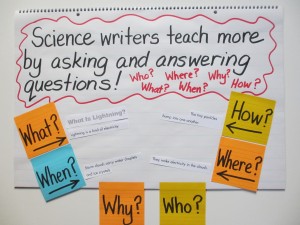
Elaboration continues to be a concern, no matter the genre, no matter the grade. Charts such as this give concrete examples of how writers can elaborate on ideas and knowledge by explicitly annotating the questions and providing examples from a published text. Keeping the five W’s, plus the How, in mind makes it much easier to elaborate because it gives kids possibly six ways to elaborate each and every time.
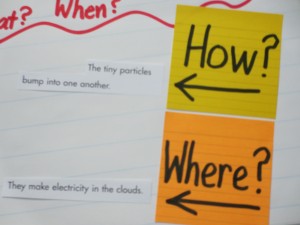
Another goal for this unit was to teach children how to write well about their science topics. Writing was not just to record the results of experiments, but to turn this newly found knowledge into writing that would encapsulate all that was learned and could teach lots of folks about the topic. Once again, turning to mentor authors helps insure there is a clear vision of what is possible and how one might go about getting there. Yes, a picture is indeed worth a thousand words.
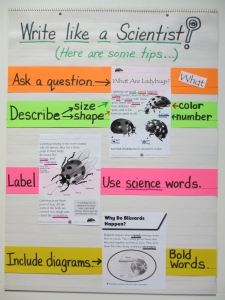
The purpose of this chart is to provide clear examples, while also setting clear expectations of what science writers should include when writing texts designed to teach. The next step will be to have kids use this chart as a way of comparing their own writing to the writing on the chart. They can write their names on post-its and put them next to the types of craft moves they have tried. Teachers can also photocopy student examples and hang these next to the published authors, which furthers children’s sense of competency and accomplishment.
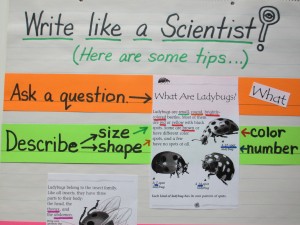
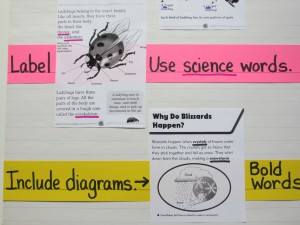
This is an example of a chart that was created with students based on what they had noticed as they studied mentor texts. It also specifically highlights craft moves that have been taught and makes clear expectations for what writers should include in their own writing. It also provides multiple entry points for crafting writing. In other words, there is something for everyone. When asked to place their name next to strategies tried, everyone will be able to feel successful.
These types of charts can be used for any genre, any subject. If you are planning to end the school year with a unit on poetry, for example, you can imagine some poems you might annotate with the kids. You might highlight topic, title, line breaks, repetition, word choice, punctuation, last lines, and so on. This type of chart has endless possibilities, as do teachers!
Happy charting!
Marjorie Martinelli and Kristine Mraz
Original article and pictures take http://chartchums.wordpress.com/2012/05/29/winding-it-down-while-ratcheting-it-up/ site
Комментариев нет:
Отправить комментарий